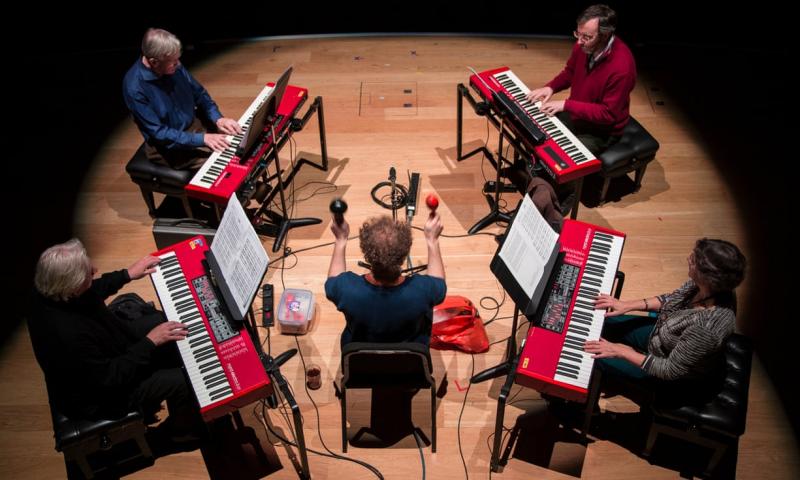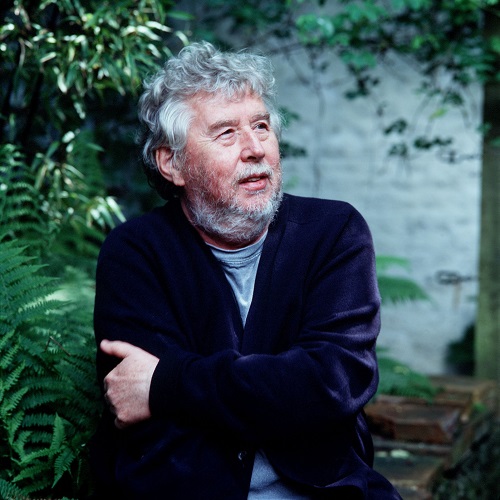Lawson, London Sinfonietta, Kings Place Review – diverse explorations of time | reviews, news & interviews
Lawson, London Sinfonietta, Kings Place Review – diverse explorations of time
Lawson, London Sinfonietta, Kings Place Review – diverse explorations of time
A surprise late addition from Birtwistle is the highlight of wide-ranging programme

Kings Place takes a broad and "curated" approach to season programming, and events often have to fit into very nebulous and abstract themes. This concert by the London Sinfonietta was part of a strand called "Time Unwrapped" and sought to explore the role of time in music.
The evening began with a pianola demonstration from Rex Lawson, the instrument’s acknowledged contemporary master. Lawson performs ("pedals", as he puts it) on an upright mahogany-encased unit that fits onto the front of a standard piano, in this case the Kings Place Steinway. His introductions were affable and entertaining, but without going into too much detail about the workings of his device – so much the better, the mystery is part of the appeal. He was more articulate on the role of rubato in pianola performance, performing rolls of Rachmaninov and Chopin, in which the pianolist is required to consciously disrupt the metrical flow, and also an interesting one from Percy Grainger, Shepherd’s Hey, where the composer had indicated the tempo changes himself on the roll. But the highlight was a series of Nancarrow Studies, music that Lawson acknowledged was written for fully mechanical performance, but then went on to demonstrate the value of having a human foot on the accelerator pedal in some truly exhilarating readings.
As the clock struck eight, we moved on to a segment of American Minimalism. Morton Feldman’s Bass Clarinet and Percussion is a typical late work, with quiet repeating modules in the clarinet accompanied by two percussionists, playing inscrutable, quiet clusters in rhythmic unison. Feldman often makes huge technical demands on his players to only middling musical effect for his listeners, but the efforts of these three performers mostly paid off. Clarinettist Robert Plane sometimes struggled to maintain the evenness of his tone, especially in the continuous high, quiet music, yet the endlessly still mood persisted, and to eerie effect. This was followed by Steve Reich’s early work Four Organs. This is Reich at his most confrontational, presenting simple rhythmic patterns in gradual evolution, without any apparent concern for the musical implications of their resulting dissociation. But the squelchy, analogue synthesisers provided appealing period sound. Kudos, too, to percussionist Louise Goodwin, who had the unenviable task of playing a continuous quaver pace on maracas throughout the whole work.
 The third segment opened with Birtwistle’s Pulse Sampler (1981), but the composer had substantially rewritten the work, even since the programme went to press. The note described the piece as for oboe and claves, but the stage was set up with a substantial percussion section instead. Birtwistle (pictured left by Hanya Chlala) introduced the performance, and it was clear that he had been inspired by the theme of this concert to revisit the piece. He also mentioned a recent visit to the exhibition of Anni Albers’ work at Tate Modern. She was a member of the Bauhaus group who specialised in weaving. The connection for Birtwistle was the parallel between the fixed lateral dimension of weaving and the role of pulse in music.
The third segment opened with Birtwistle’s Pulse Sampler (1981), but the composer had substantially rewritten the work, even since the programme went to press. The note described the piece as for oboe and claves, but the stage was set up with a substantial percussion section instead. Birtwistle (pictured left by Hanya Chlala) introduced the performance, and it was clear that he had been inspired by the theme of this concert to revisit the piece. He also mentioned a recent visit to the exhibition of Anni Albers’ work at Tate Modern. She was a member of the Bauhaus group who specialised in weaving. The connection for Birtwistle was the parallel between the fixed lateral dimension of weaving and the role of pulse in music.
To this end, he recreated Pulse Sampler, originally for solo oboe with percussion accompaniment, into a full duet between the two players. The new percussion part is still dominated by woody sounds, a range of wood blocks and temple blocks, but also expands into cymbals and untuned metallic percussion, as well as a cajón (a first for Birtwistle?) on which the percussionist sits. An excellent performance here from both players, but especially oboist Melinda Maxwell, always lyrical and clear, despite Birtwistle’s often tortuous lines. And to conclude, Stockhausen’s Zeitmasse, an early work for wind quintet (cor anglais replacing horn). Birtwistle implied that Stockhausen got the heart of the programme’s time theme better than any of the preceding composers. Unusually, he did so without any overt theorising or applied philosophy, and the Sinfonietta did his score full justice, a core-repertoire piece, if ever there was one for this ensemble.
rating
Explore topics
Share this article
The future of Arts Journalism
You can stop theartsdesk.com closing!
We urgently need financing to survive. Our fundraising drive has thus far raised £49,000 but we need to reach £100,000 or we will be forced to close. Please contribute here: https://gofund.me/c3f6033d
And if you can forward this information to anyone who might assist, we’d be grateful.

Subscribe to theartsdesk.com
Thank you for continuing to read our work on theartsdesk.com. For unlimited access to every article in its entirety, including our archive of more than 15,000 pieces, we're asking for £5 per month or £40 per year. We feel it's a very good deal, and hope you do too.
To take a subscription now simply click here.
And if you're looking for that extra gift for a friend or family member, why not treat them to a theartsdesk.com gift subscription?
more Classical music
 Bizet in 150th anniversary year: rich and rare French offerings from Palazzetto Bru Zane
Specialists in French romantic music unveil a treasure trove both live and on disc
Bizet in 150th anniversary year: rich and rare French offerings from Palazzetto Bru Zane
Specialists in French romantic music unveil a treasure trove both live and on disc
 Scottish Chamber Orchestra, Ibragimova, Queen’s Hall, Edinburgh review - rarities, novelties and drumrolls
A pity the SCO didn't pick a better showcase for a shining guest artist
Scottish Chamber Orchestra, Ibragimova, Queen’s Hall, Edinburgh review - rarities, novelties and drumrolls
A pity the SCO didn't pick a better showcase for a shining guest artist
 Kilsby, Parkes, Sinfonia of London, Wilson, Barbican review - string things zing and sing in expert hands
British masterpieces for strings plus other-worldly tenor and horn - and a muscular rarity
Kilsby, Parkes, Sinfonia of London, Wilson, Barbican review - string things zing and sing in expert hands
British masterpieces for strings plus other-worldly tenor and horn - and a muscular rarity
 From Historical to Hip-Hop, Classically Black Music Festival, Kings Place review - a cluster of impressive stars for the future
From quasi-Mozartian elegance to the gritty humour of a kitchen inspection
From Historical to Hip-Hop, Classically Black Music Festival, Kings Place review - a cluster of impressive stars for the future
From quasi-Mozartian elegance to the gritty humour of a kitchen inspection
 Shibe, LSO, Adès, Barbican review - gaudy and glorious new music alongside serene Sibelius
Adès’s passion makes persuasive case for the music he loves, both new and old
Shibe, LSO, Adès, Barbican review - gaudy and glorious new music alongside serene Sibelius
Adès’s passion makes persuasive case for the music he loves, both new and old
 Anja Mittermüller, Richard Fu, Wigmore Hall review - a glorious hall debut
The Austrian mezzo shines - at the age of 22
Anja Mittermüller, Richard Fu, Wigmore Hall review - a glorious hall debut
The Austrian mezzo shines - at the age of 22
 First Person: clarinettist Oliver Pashley on the new horizons of The Hermes Experiment's latest album
Compositions by members of this unusual quartet feature for the first time
First Person: clarinettist Oliver Pashley on the new horizons of The Hermes Experiment's latest album
Compositions by members of this unusual quartet feature for the first time
 Gesualdo Passione, Les Arts Florissants, Amala Dior Company, Barbican review - inspired collaboration excavates the music's humanity
At times it was like watching an anarchic religious procession
Gesualdo Passione, Les Arts Florissants, Amala Dior Company, Barbican review - inspired collaboration excavates the music's humanity
At times it was like watching an anarchic religious procession
 Classical CDs: Camels, concrete and cabaret
An influential American composer's 90th birthday box, plus British piano concertos and a father-and-son duo
Classical CDs: Camels, concrete and cabaret
An influential American composer's 90th birthday box, plus British piano concertos and a father-and-son duo
 Cockerham, Manchester Camerata, Sheen, Martin Harris Centre, Manchester review - re-enacting the dawn of modernism
Two UK premieres added to three miniatures from a seminal event of January 1914
Cockerham, Manchester Camerata, Sheen, Martin Harris Centre, Manchester review - re-enacting the dawn of modernism
Two UK premieres added to three miniatures from a seminal event of January 1914
 Kempf, Brno Philharmonic, Davies, Bridgewater Hall, Manchester review - European tradition meets American jazz
Bouncing Czechs enjoy their Gershwin and Brubeck alongside Janáček and Dvořák
Kempf, Brno Philharmonic, Davies, Bridgewater Hall, Manchester review - European tradition meets American jazz
Bouncing Czechs enjoy their Gershwin and Brubeck alongside Janáček and Dvořák
 Solomon, OAE, Butt, QEH review - daft Biblical whitewashing with great choruses
Even a top soprano and mezzo can’t make this Handel paean wholly convincing
Solomon, OAE, Butt, QEH review - daft Biblical whitewashing with great choruses
Even a top soprano and mezzo can’t make this Handel paean wholly convincing
